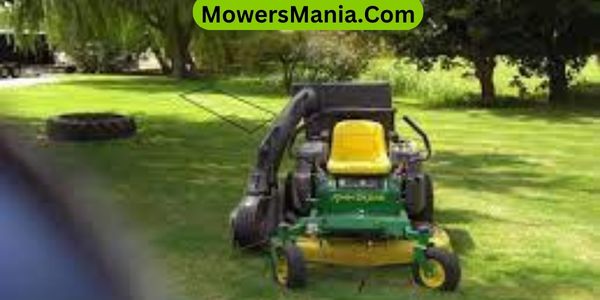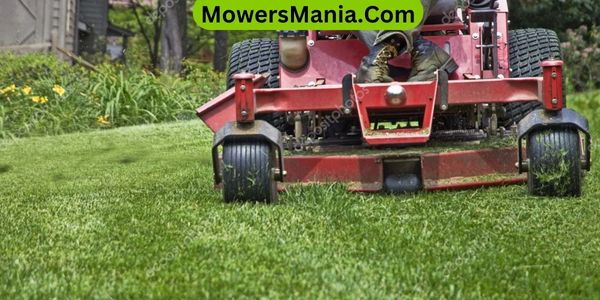Are you tired of your riding mower turning your lawn into a bumpy, uneven mess? It might be frustrating to see your mower constantly scalping the grass, but don’t worry – there are solutions to this common problem.
By understanding the reasons behind the scalping, you can make the necessary adjustments to achieve a smooth, well-maintained lawn.

In this article, we’ll explore five common reasons why your riding mower is scalping the lawn, and provide practical tips to help you address these issues.
So, let’s dive in and get your lawn looking lush and healthy again!
Incorrect Deck Height Adjustment
If your riding mower is scalping the lawn, it may be because you haven’t adjusted the deck height correctly. When the deck is set too low, the blades end up cutting the grass too short, resulting in scalping.
To rectify this, you should first consult your mower’s manual to locate the deck adjustment lever or knob. Once located, adjust the deck height to the recommended setting for the type of grass in your lawn.
It’s essential to ensure that the mower is on a level surface when making this adjustment to guarantee an even cut across the entire lawn.
Remember to regularly check and adjust the deck height as needed, especially if you have uneven terrain in your yard. Additionally, inspect the blades for wear and tear, as dull or damaged blades can also contribute to scalping.
Uneven Terrain and Slopes
To avoid scalping the lawn with your riding mower, carefully navigate uneven terrain and slopes to prevent the blades from cutting the grass too short.
Uneven terrain and slopes can pose a challenge when mowing your lawn, but with the right approach, you can minimize the risk of scalping.
Here’s how to handle these tricky areas:
- Slow Down: When you encounter uneven terrain or slopes, reduce your speed to give the mower deck more time to adjust to the changes in the landscape.
- Choose the Right Path: Try to mow across slopes instead of up and down. This technique can help the mower deck follow the contours of the land more evenly.
- Use the Deck Height Adjustment: Adjust the cutting deck to a higher setting when mowing on uneven terrain or slopes. This will help the blades avoid cutting the grass too closely.
- Plan Your Route: Before mowing, take a walk around the yard to identify areas with uneven terrain or slopes. Plan your mowing route to navigate these areas strategically, minimizing the risk of scalping.
Worn or Damaged Mower Blades

Check the condition of your riding mower’s blades to determine if they are worn or damaged. Worn or damaged blades can cause your mower to scalp the lawn, leaving behind uneven patches of grass.
It’s essential to inspect the blades regularly for signs of wear and tear, such as nicks, bends, or dull edges. If you notice any of these issues, it’s crucial to replace the blades to ensure a clean and even cut.
To emphasize the importance of maintaining sharp and undamaged mower blades, consider the following table:
| Condition | Effect | Solution |
|---|---|---|
| Worn blades | Uneven cutting and scalping of the lawn | Replace the blades |
| Damaged blades | Tearing or shredding of grass | Replace the blades |
| Dull edges | Ragged, brown-tipped grass | Sharpen or replace blades |
Regularly checking and maintaining your mower blades is vital for achieving a well-manicured lawn. By promptly addressing worn or damaged blades, you can prevent unsightly scalping and promote healthy grass growth.
Inadequate Tire Inflation
Inspect your riding mower’s tire pressure to ensure that inadequate inflation isn’t contributing to lawn scalping. Proper tire inflation is crucial for maintaining an even cutting height and preventing the mower deck from bottoming out on uneven terrain.
Here are a few reasons why inadequate tire inflation can lead to lawn scalping:
- Uneven Weight Distribution: When the tires aren’t properly inflated, it can lead to uneven weight distribution across the mower deck, causing it to tilt and scalp the lawn in certain areas.
- Reduced Ground Clearance: Inadequately inflated tires can decrease the ground clearance of the mower, making it more prone to scalping the lawn, especially over bumps and uneven surfaces.
- Loss of Traction: Low tire pressure can reduce traction, causing the mower deck to dip lower than intended, resulting in scalping as it traverses the lawn.
- Increased Ground Pressure: Insufficient tire inflation increases the ground pressure exerted by the mower, making it more likely to scalp the grass, especially on softer ground.
Regularly check and maintain the proper tire pressure according to the manufacturer’s recommendations to prevent lawn scalping due to inadequate tire inflation.
Excessive Mowing Speed

Ensure that your riding mower’s speed isn’t excessive, as it can contribute to lawn scalping. Mowing too fast doesn’t allow the mower deck enough time to adjust to changes in the lawn’s contour, resulting in uneven cutting and potential scalping.
When you mow too quickly, the mower may ride up over humps and depressions in the lawn, causing the blades to cut too low in certain areas. This can leave your lawn with unsightly patches and uneven grass height.
To prevent this, adjust your mowing speed to a pace that allows the mower deck to follow the natural contours of the lawn, ensuring a more uniform cut. Slower speeds also allow the blades to properly mulch the grass clippings, promoting a healthier lawn.
Keep in mind that different mowers may have varying recommended speeds for optimal cutting, so consult your mower’s manual for specific guidelines.
Frequently Asked Questions [FAQs]
Can Using a Riding Mower With a Scalping Problem Cause Long-Term Damage to My Lawn?
Using a riding mower with a scalping problem can cause long-term damage to your lawn. The repeated cutting of the grass too short can stress the turf and lead to thinning and brown patches over time.
Are There Any Additional Maintenance Tips I Should Follow to Prevent My Riding Mower From Scalping the Lawn?
To prevent scalping, adjust the deck height of your riding mower to match the grass length. Keep the blades sharp and level. Regularly inspect and maintain the mower’s tires, and avoid mowing wet grass.
How Can I Determine if My Riding Mower’s Tire Inflation Is Inadequate and Causing Scalping?
Check your riding mower’s tire pressure by using a gauge. If the tires are underinflated, this could be causing the scalping. Inflate the tires to the recommended pressure as specified in the owner’s manual.
What Are Some Signs That My Riding Mower’s Blades Are Worn or Damaged, Leading to Scalping?
If your riding mower’s blades are worn or damaged, signs include uneven cutting, ragged edges on grass, and visible nicks or bends. Check blades for wear and tear, and replace if necessary to prevent further scalping of the lawn.
Is There a Recommended Mowing Speed to Prevent Scalping, and How Can I Measure and Adjust My Speed While Mowing?
To prevent scalping, maintain a steady mowing speed. Use a timer or measure your speed over a set distance. Adjust your speed as needed to prevent scalping and achieve an even cut across your lawn.
Conclusion
So there you have it – if your riding mower is scalping your lawn, it could be due to:
- Incorrect deck height adjustment
- Uneven terrain
- Worn blades
- Inadequate tire inflation
- Excessive mowing speed
By addressing these issues and making the necessary adjustments, you can ensure a clean and even cut for your lawn.
Happy mowing!



